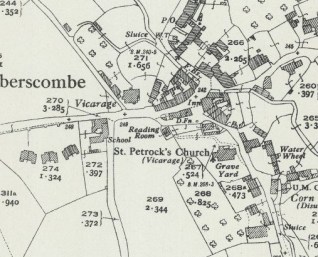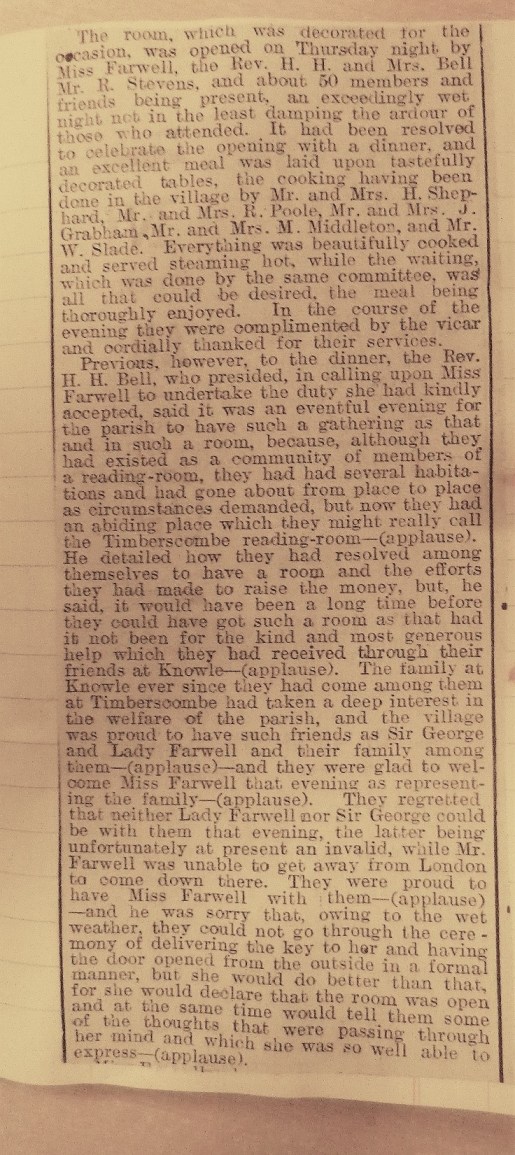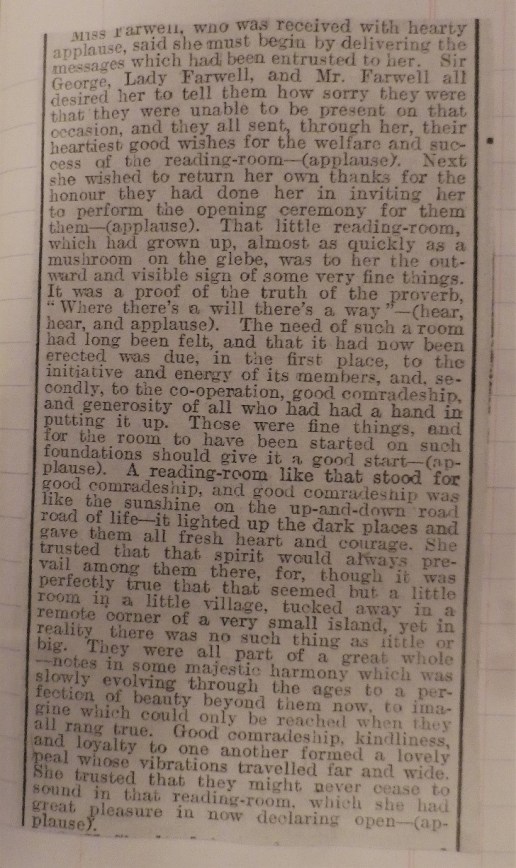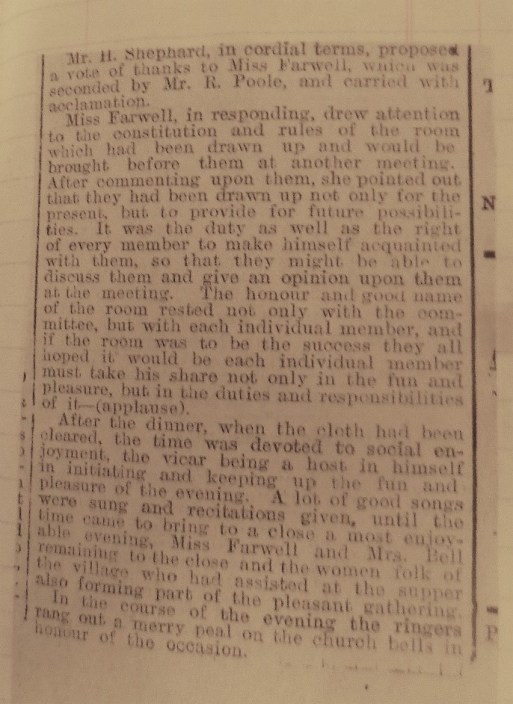
A “Community of Members of a Reading Room” appears to have been formed some time before 1913. Without a permanent home, the members used several habitations and moved from place to place as circumstances demanded.
On 1st September 1913 a meeting was held in the “Old Room”[1]. The purpose of the meeting was to discuss the building of a new Reading Room for Timberscombe. The minutes of the Reading Room Committee between 1913 and 1939 are held in the Somerset Heritage Centre [2]
The vicar, Herbert Bell, who chaired the meetings, reported in September 1913 that the funds for the new room stood at £31.9.0. The cost of a new room of 35ft by 18ft or 30ft by 20ft was estimated to be about £60. The minute book records that, “Sir George Farwell, Lady Farwell and Miss Farwell (of Knowle) had most generously agreed to provide the balance of the cost”
After much discussion the minute book records that “the most suitable and convenient spot would be the North East corner of the “club” field and the vicar expressed his willingness to accept that site and undertook to obtain the consent of the Bishop as patron of the Living…….on the understanding that there should be a small acknowledgement annually” The area described as the “club” field was the area now containing the telephone box and Glebe parking. Below is the 1921-43 OS map which shows the Reading Room in the centre of Timberscombe.

The following committee was appointed to explore the details of the site and buildings available:
The Vicar (Herbert Bell), Mr Shephard, Mr Blackmore, Mr Grabham, Mr Middleton,
Mr Poole, Mr Falmer.
A room of 30 ft by 18ft appears to have been agreed and was erected by the end of 1913 by a Mr Harrison. Below is the press cutting of the opening ceremony:



A constitution was drawn up for the new Committee of Management along with Rules for Members. A transcript of the Rules for Members can be viewed below. The original document is held at the Somerset Heritage Centre (Doc ref: D/P/timb/10/3/2), :
- The Reading Room is open to members only, except that a member may bring as a guest a friend non-resident in Timberscombe Parish.
- Any man living in the Civil Parish of Timberscombe and over the age of sixteen may become a member by paying the subscription quarterly in advance, and continue to be a member until he resigns or fails (to pay his subscription for twenty-eight days after it has become due). The Trustees on the application of the Committee of Management have the right to refuse admission to membership.
- The minimum subscription is 1/6 for each of the winter quarters and 6d for each of the summer quarters. Subscriptions may be paid to the Chairman of the Committee of Management, or to the Treasurer, or to any member that the Committee of Managements shall appoint for the purpose.
- The Room is open every weekday evening from 6pm to 10pm. Members may obtain permission from the Committee of Management to use the Room after 10pm on a weekday if they undertake to lock up the Room on leaving.
- Games of bagatelle, cards, draughts, etc may be played in an orderly manner.
- Songs may be sung by consent of a majority of the members present.
- Books belonging to the Room may be read in the Room but they must not be taken away except by permission of a member of the Committee of Management who shall be held responsible for that book, and the name of the book and the person taking it must be entered in the book kept for that purpose before the book is removed from the Room.
- Due order and proper behaviour must be observed, and anyone who swears or who uses bad language shall be fined 6d.
- Gambling or betting in any form is strictly forbidden. (This does not prevent whist drives for prizes)
- The management of the Room is in the hands of the Committee of Management.
- Any member who does not observe these Rules or who is guilty of disorderly conduct shall be reported to the Committee of Management and the Committee may (after hearing the accused members should he wish to be heard) suspend him or expel him.
- In the event of any dispute the member has the right of appeal to the Trustees.
A caretaker was later employed by the Committee to sweep and dust the room each day and to light the fire and lamps each evening.
The 1922-23 expenditure for the Room included a half-size billiards table, coal, firewood, half a dozen rings, a packet of needles, stationery, rates and insurance. The income included subscriptions and billiard fees.
In 1929 the Room was purchased from the Diocese of Bath and Wells by the Administrative Trustees of Timberscombe Reading Rooms. The conveyance document held at SHC describes the land as “a corner of Parsonage Close of about 3 perches”.
1935 saw the purchase of a second-hand ¾ size billiards table from Spencer’s of Bristol at a cost of £45 to replace the smaller ½ size table. The table was officially “opened” on 11th March 1935 by a game of 25 up between Mr Morel and Mr Stevens. A billiard tournament was later agreed with a cup for the winner.
The Reading Room purchased three regular newspapers for members to read and 6 tables were purchased for whist drives.
1936 saw the first electric light added and it was officially switched on by Mr W.G. Morel on 18th December 1936.
Disaster struck, on 14th February 1944, when the Reading Room was burnt down. The cause of the disaster was a young boy from the village school (name withheld!!) who decided it would be fun to set fire to a nearby pile of straw. The blaze quickly spread to the Reading Rooms destroying everything. During the war years the Reading room had been used by the School to educate evacuees. The Head Teacher’s log records that the fire destroyed 13 desks from Bristol, 4 from West Ham and 6 from Somerset, presumably provided for each of their evacuees. The rooms were valued by the insurance company at the time at £300.
It was not until after the war that steps were taken to replace the Reading Room with a Village Hall. Click on this link to see the History of the Village Hall .
[1] All other meetings were held in the Vicarage so the “Old Room” may have been the name of a room in the vicarage.
[2] Ref D\P\timb/10/3

